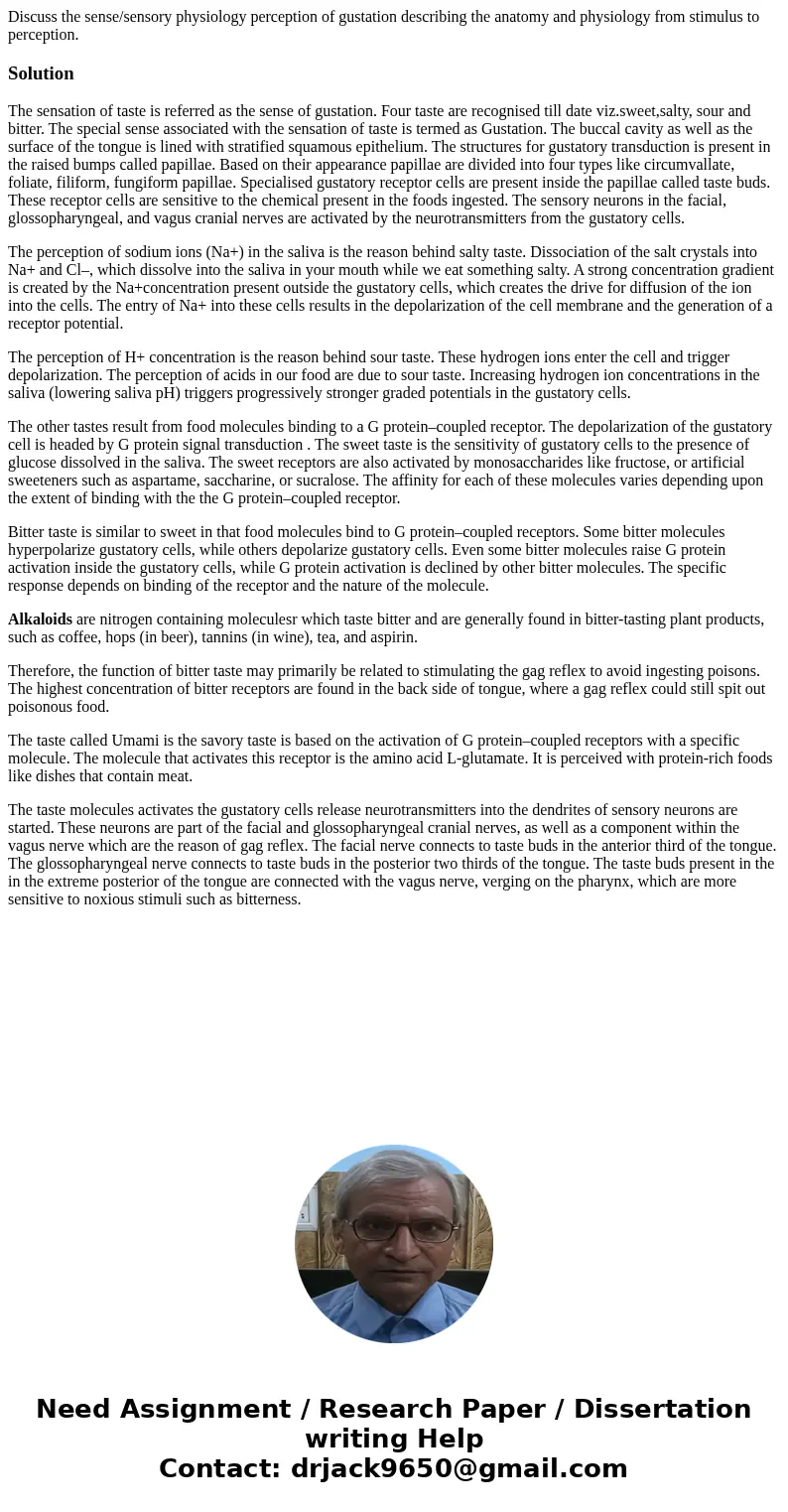Discuss the sensesensory physiology perception of gustation
Discuss the sense/sensory physiology perception of gustation describing the anatomy and physiology from stimulus to perception.
Solution
The sensation of taste is referred as the sense of gustation. Four taste are recognised till date viz.sweet,salty, sour and bitter. The special sense associated with the sensation of taste is termed as Gustation. The buccal cavity as well as the surface of the tongue is lined with stratified squamous epithelium. The structures for gustatory transduction is present in the raised bumps called papillae. Based on their appearance papillae are divided into four types like circumvallate, foliate, filiform, fungiform papillae. Specialised gustatory receptor cells are present inside the papillae called taste buds. These receptor cells are sensitive to the chemical present in the foods ingested. The sensory neurons in the facial, glossopharyngeal, and vagus cranial nerves are activated by the neurotransmitters from the gustatory cells.
The perception of sodium ions (Na+) in the saliva is the reason behind salty taste. Dissociation of the salt crystals into Na+ and Cl–, which dissolve into the saliva in your mouth while we eat something salty. A strong concentration gradient is created by the Na+concentration present outside the gustatory cells, which creates the drive for diffusion of the ion into the cells. The entry of Na+ into these cells results in the depolarization of the cell membrane and the generation of a receptor potential.
The perception of H+ concentration is the reason behind sour taste. These hydrogen ions enter the cell and trigger depolarization. The perception of acids in our food are due to sour taste. Increasing hydrogen ion concentrations in the saliva (lowering saliva pH) triggers progressively stronger graded potentials in the gustatory cells.
The other tastes result from food molecules binding to a G protein–coupled receptor. The depolarization of the gustatory cell is headed by G protein signal transduction . The sweet taste is the sensitivity of gustatory cells to the presence of glucose dissolved in the saliva. The sweet receptors are also activated by monosaccharides like fructose, or artificial sweeteners such as aspartame, saccharine, or sucralose. The affinity for each of these molecules varies depending upon the extent of binding with the the G protein–coupled receptor.
Bitter taste is similar to sweet in that food molecules bind to G protein–coupled receptors. Some bitter molecules hyperpolarize gustatory cells, while others depolarize gustatory cells. Even some bitter molecules raise G protein activation inside the gustatory cells, while G protein activation is declined by other bitter molecules. The specific response depends on binding of the receptor and the nature of the molecule.
Alkaloids are nitrogen containing moleculesr which taste bitter and are generally found in bitter-tasting plant products, such as coffee, hops (in beer), tannins (in wine), tea, and aspirin.
Therefore, the function of bitter taste may primarily be related to stimulating the gag reflex to avoid ingesting poisons. The highest concentration of bitter receptors are found in the back side of tongue, where a gag reflex could still spit out poisonous food.
The taste called Umami is the savory taste is based on the activation of G protein–coupled receptors with a specific molecule. The molecule that activates this receptor is the amino acid L-glutamate. It is perceived with protein-rich foods like dishes that contain meat.
The taste molecules activates the gustatory cells release neurotransmitters into the dendrites of sensory neurons are started. These neurons are part of the facial and glossopharyngeal cranial nerves, as well as a component within the vagus nerve which are the reason of gag reflex. The facial nerve connects to taste buds in the anterior third of the tongue. The glossopharyngeal nerve connects to taste buds in the posterior two thirds of the tongue. The taste buds present in the in the extreme posterior of the tongue are connected with the vagus nerve, verging on the pharynx, which are more sensitive to noxious stimuli such as bitterness.

 Homework Sourse
Homework Sourse